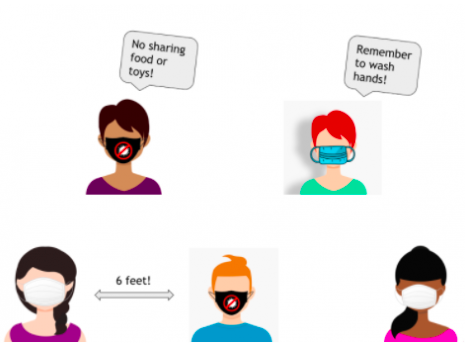Elementary teachers, students adjust to new COVID-19 protocols

Graphic by Allison Gillman ’23 and Lucy Dockter ’23
Elementary school students and staff demonstrate responsibility and resilience while adhering to new public safety protocols due to the COVID-19 pandemic.
Here at Staples, we have settled into a new ordinary. Coming into school two days a week, you squeeze some hand sanitizer into your palm, put on a mask and rush to your first period class.
But how does a school day work for the elementary students and for the dedicated educators who teach them? How have they all adjusted to the masks, distancing, hand washing and complicated hallway regimens?
Before the year began, parents and faculty expressed concern over how our youngest learners would adjust. However, fears have been assuaged as students and teachers alike have adapted to the routines under COVID-19.
“We haven’t had any concerns with [the children] keeping their masks on, or socially distancing, or following any of the safety protocols,” Janna Sirowich, Coleytown Elementary School (CES) principal, said. “They have been superb.”
The cooperation of the younger students at school has been a pleasant surprise in the midst of such a stressful time. For Greens Farms (GFS) teacher Jessica Olson, her kindergarteners have been a model of the cautious behavior that even adults should emulate.
“If you’re a middle school teacher it’d be hard to know if your kids wash their hands,” Olson said, “but as a kindergarten teacher I see them, and they want to please me so that’s very easy.”
The elementary student body is separated into two cohorts. Last names A-K attend school in the morning, while L-Z go in the afternoon. Students go to school in person five days a week, with the morning and afternoon rotation switching every quarter.
The district has focused this limited in-person time on literacy and math for the younger students. All specials classes — music, P.E., art and Spanish — are taught online.
CES physical education teacher, Chris Scholz, has come up with creative and innovative ways to enhance his classes. He instructs all of his students over zoom, broadcasting by himself from Coleytown’s gym.
“I’m talking to the children on this tiny little computer screen, and our challenge is that it’s physical education, so I have to see [the students] being active and give feedback,” Scholz said, standing up to demonstrate how he teaches a PE class over Zoom. “I don’t want to be staring at the […] teeny, tiny bodies moving, so I was able to get a second camera where I can broadcast myself actually moving around with them.”
Initial trepidation about students following safety protocols has dissipated, yet there are still concerns over the interpersonal relationships between teachers and students. GFS teacher Michelle DeCarlo especially values connection with her third graders.
Under ordinary circumstances, DeCarlo uses enthusiasm and physical connection to develop bonds between herself and her students.
“I like to be loud, I like to have fun, I like to walk all around the classroom or draw them all in on the carpet […]” DeCarlo said, cracking a smile. “They don’t really get out of their seats at all, which is a really big downfall because at this age they need to be moving around.”
As is currently the case with every school faculty member across America, there is a tremendous learning curve that comes with adjusting to a completely new educational model. CES Psychologist Dr. Kim Kassay emphasizes the importance of patience during this period, as teachers and staff work hard not only to ensure student safety, but to provide them with the best education possible in a COVID world.
Kassay believes that alignment and cooperation among administration, staff, parents and students will be essential to a successful school year.
“Working together is something that really amazed me last year when we were at the height of the pandemic and there was so much going on, and how everybody really came together […]” Kassay said. “That mindset was what got us through such a hard time and I hope that mindset sticks, that everybody realizes that we are still in this together, especially at the elementary level.”
0060,69529″ align=”center” background=”on” border=”all” shadow=”on”]
















































